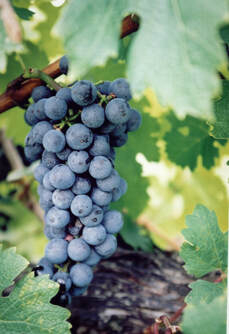 Harvest starts this week. All of the work in the vineyard, from winter's pruning to summer's hedging, leads up to this final push of ripening and the decision-making around when to pick each variety of grapes. By my count, Allegro grows about 17 different varieties of grapes, between our vineyards in The Brogue and those in Stewartstown. But there is only one place where we grow my favorite red variety: Cabernet Sauvignon. It was first planted in The Brogue's vineyards, in what we now call "Block 3," in 1973. These old vines have many stories to tell. Most of the Cabernet grapes have now undergone verasion, having turned the deep blue which indicates that grape-growing has finished and grape-ripening has begun. I love to see the grapes at this stage and have always thought that they resemble little worlds. 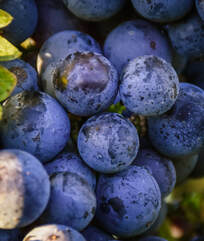 These Cabernet globes makes me think of two specific (but quite different) references: Horton Hears a Who!, and Men in Black. In the Dr. Seuss book, Horton the Elephant has to convince the world to save the tiny planet Whoville, which is so small it is carried on a piece of dust. In the Will Smith/Tommy Lee Jones movie, they discover a marble-sized galaxy hanging on the collar of a cat. In both of these imaginings, tiny worlds are discovered to be in need of protection. While we certainly do a lot to take care of our grapes in the course of a year, they are also out there on their own, vulnerable to whatever weather comes our way during the weeks of ripening. 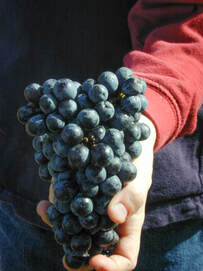 I'm not suggesting that the blue grapes, born from an unlikely cross between parents Cabernet Franc and Sauvignon Blanc, contain alien worlds, but they certainly do have mystery within them. How ripe will they get this year? How much flavor development will occur? (When) Will late-season hurricane remnants blow through, or early frosts come, which will preemptively end their season? In the very best year, the grapes can hang out until their seeds are like grape nuts and their Brix (sugar content) reaches at least 22. The harvest photo here was taken on the first day of November, 2005--the longest we've ever left them hanging! (The grapes are being held by our then-five-year-old son, who is now a college junior.) In the very best vintages, the Cabernet Sauvignon grapes are allowed to become so successfully ripe that they get the true "king" treatment in the cellar, being put in the best oak barrels for up to two years, after which they are bottled as our finest--and most ageable--flagship Cadenza wines. I have tasted Allegro Cabernets bottled long before our time here--wines more than thirty-five years old--and the long history is a tasty one. So we watch and we wait, vigilant as Horton and Mr. Smith and Mr. Jones. With sun and luck and thoughtful tending, this mess of a year could still result in a beautiful world of a wine. Cheers, Kris
0 Comments
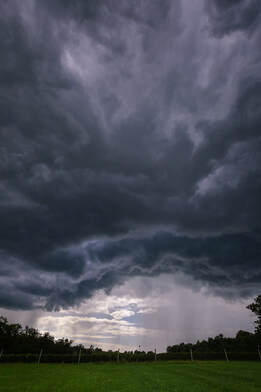 At Allegro's vineyards in The Brogue, we have often experienced the ways that bad weather systems sometimes seem to dissolve or break up, rather than score a direct hit on us. (Here's a pic of the thunderstorm on Tuesday, which would seem to corroborate this impression.) This can perhaps give us a sense of false security, as we come to imagine that maybe bad weather and bad news are willing to stay away from this little fortunate corner of the world. Wednesday our vineyard employee Matt shared horrible news with us which burst into our reality: He saw 4 spotted lanternflies in our vineyard block of Albariño, Sémillon, Sauvignon Blanc, Viognier. They're here. Carl has been anticipating the arrival of these devastating invasive insects for several years. The spotted lanternflies, indigenous to China and Vietnam, first showed up in the U.S. in 2014, in Berks County, PA. Their numbers and territory have expanded exponentially since then, posing a major threat to hardwoods, fruit trees, and grapevines. Carl knows growers whose vineyards have been absolutely wiped out by the lanternflies, including a grower in PA who lost his entire 50-acre vineyard. The planthoppers feed on the sap of the trees and plants, pulling out carbohydrates necessary for future growth. Grapevines are particularly vulnerable to this kind of loss in the fall, when the accumulation of sugars converts to starches which will fuel the following season's vital early-season growth. 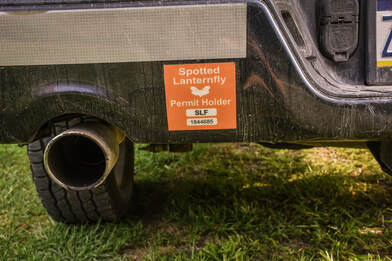 So they're here; we aren't somehow immune to these awful critters. We'd been hoping, of course, that they would pass us by, and news that they have been spotted in California led to our hoping that those in the U.S. wine industry with deep pockets will become motivated to throw lots of money into mitigation research, finding ways--fungi? spiders?--to stop the invasion. In an awful way, it sort of feels like it mimics the COVID pandemic, where the whole world is racing for a vaccine. The whole world may not care about our vines, but for us these vines--some of which have been growing here in York County since 1973--mean everything. As Carl so delicately puts it, "We're scared shitless." So far, only a few individual insects have been seen here, but sometimes, in other places, we've seen one minor infestation one year develop into a full-scale invasion the following year. The PA Department of Ag has put out lots of educational material about the insects, instructing people who see the flies to report and kill them. Carl's truck bears the sticker showing he has a permit indicating he has received Department of Ag training. (It looks like he has, instead, the right to hunt and kill the lanternflies, which of course we all do.) If you see spotted lanternflies in PA, please report them online or call 1-888-4BADFLY. 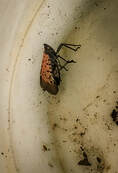 Uck Uck As a photographer I can't help but notice how interesting the spotted lanternflies look, but I've seen enough terrifying photo and video evidence of how awful infestations are that I know I'll shiver when I see my first ones in person. For now, this is the one picture I have, taken by Carl's phone. Let's hope that targeted vineyard sprays can help us keep them at bay. 2020: You were already officially the worst. We would have loved to be spared from this targeted pest. But, after all, as Red Green used to say, "Remember I'm pullin' for ya -- we're all in this together." 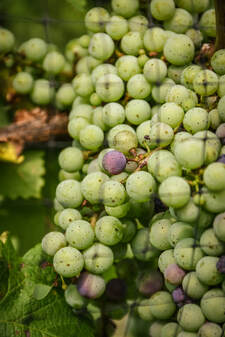 Cab Sauv Cab Sauv This morning, as I sat outside drinking my coffee, I could sense a change in the air. It was literally a change in the air, something a bit quicker, a bit cooler, and seeming to come more from the northeast than the usual south. It seemed like the critters around me were sensing something too: The butterflies were more like flutter-bys, the cardinals and finches were caught up in some drama too intense to unravel, Artemis (the yard leopard) looked ready to pounce on something completely invisible. I wondered if it could all be attributed to a subtle change in season, if this six-month-long-spring-into-summer-of-Blursdays might actually have a finite end at some point. Might be nice. Vineyard-watchers, of course, already know that changes are coming. At this time of the season, our red grapes start to undergo a transition called véraison, which is when they start to turn color. Véraison marks the end of a grape's growing season and the start of its ripening season. They start to accrue sugars, which is why we have to be more vigilant with keeping the deer and birds away. I love the look of a variegated bunch of someday-red grapes. For this short window of time, even within a bunch, there is visible diversity. It's a very pretty reminder of the fact that harvest will, indeed, come, and that the seasons will continue to change. I'm ready. 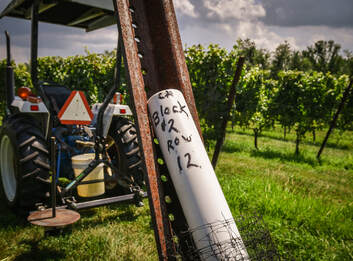 This time of the year, as the grapes start to sweeten on the vine, the vineyard crew heads out to the vineyard with a special spool attachment behind on the tractor: It's bird netting time. While Carl and I came to Allegro in 2001, that fall harvest was managed by Dick Naylor of Naylor Wine Cellars down the road. We officially purchased Allegro in early 2002, and that year's growing season and harvest were all ours: our work, our grapes, our responsibility. Carl and I had both worked for Mount Nittany VIneyard & Winery for several years prior to purchasing our own place, so we knew the vineyard seasons and a lot about the special time that is harvest. What we had never before fully experienced was how it feels to have a full-on investment in an agricultural enterprise. 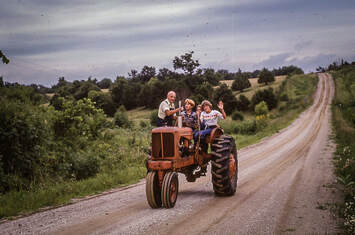 Farming goes back generations in my family, as my father grew up in Iowa working summers on his four uncles' farms. His father, like both of my parents, like me, went into the field of education rather than an actual field for his profession. We still tend to wax poetic about the farming life, and when I was a teenager my family moved outside State College, PA, to live on a mountaintop property with thirty-five acres and horses. While I really enjoy life on our "grape farms," the experience of having part of our livelihood out growing in the world, susceptible to the whims of weather and nature, is nothing if not humbling. Much can go right--this summer's mostly dry heat, for instance, makes us excited for the promise of the 2020 vintage--and much can also go wrong: late spring frosts, early fall frosts, storm remnants during hurricane season, severe winter freezing. Carl tells me that he doesn't stress over the weather, because he can't control it. He stresses over the wines, which are within his purview. By contrast, I tend to stress about the things I can't control. Like birds. Back in 2002, the vineyard was ours. Over the course of one afternoon that September, we went from anticipating a full grape harvest to realizing that we would only have enough harvestable Chardonnay to produce a single barrel of wine. What stole away or damaged all of those grapes? Flocks of birds that came around when we weren't looking and apparently had no respect for the loud electronic "squawkers" we had in the vineyard, mimicking the sounds of predatory birds. Birds came and went while we weren't watching. The grapes were gone. I remember feeling disbelief that our fortunes could turn so quickly. Oof. 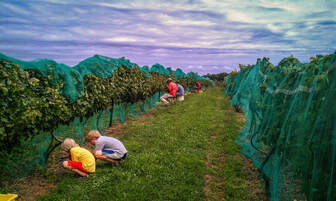 2011 2011 So, beginning with the growing season of 2003, you can bet that we started putting bird nets out over all of the vines in August. To way understate things, bird nets are a pain. They get damaged. They get tangled. Vines get tangled in them. Snakes get tangled in them. They are a pain to put on, to take off, to roll up, to store. They are a real pain during grape harvest days. But all of that pain still doesn't outweigh the pain of losing a full crop to a rogue feathered gang. 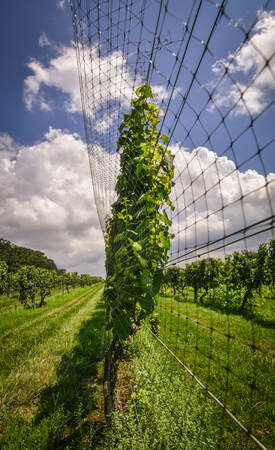 These days, as the vineyard management has become more seasoned, Allegro has adapted our bird netting, now using narrower nets that don't have to go all the way over the top of the rows. The black nets are more aesthetically pleasing than the old white or emerald green nets, but they still do the job. The worrying part of me is always grateful when I see those nets come out every summer. It takes hours and ours of time in the vineyard to get all of them in place, but it's nice to have some measure of peace regarding one thing which we can take some control of. We are vigilant these days, keeping an eye out for the likely inevitable future infestation of spotted lanternflies, the strange invasive insects which have the power to devastate vineyards. Remarkably, we have not yet seen the lanternflies in our vineyards, though they are in counties all around us and have even made it across the country from Pennsylvania to Napa Valley. Nets won't help safeguard us against those bugs. (Here's a local news story which includes an interview with Carl.) Some days, it does seem like there isn't much we do have the power to control. Some days, we do feel vulnerable. Farming does take a strong gut. And humility. And vigilance. And, sometimes, miles of bird netting. But still, it is rich with rewards. Every year we grow here, we get to anticipate and realize the vineyard's potential. Like all of the farmers before us, we get to look forward to what comes next.
|
Archives
July 2021
Categories |
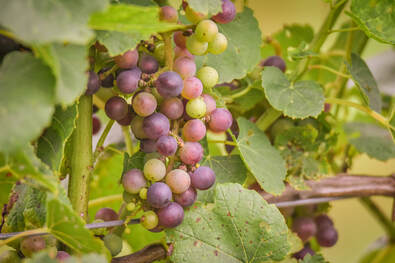
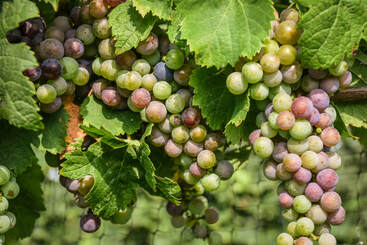
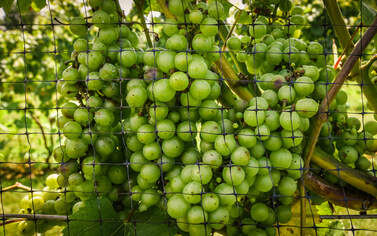
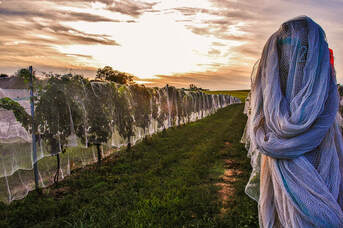
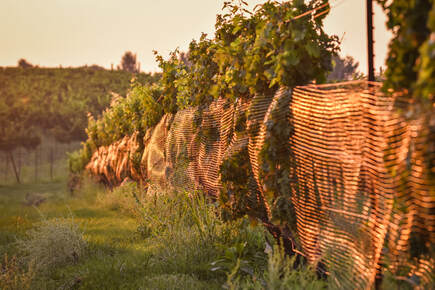
 RSS Feed
RSS Feed